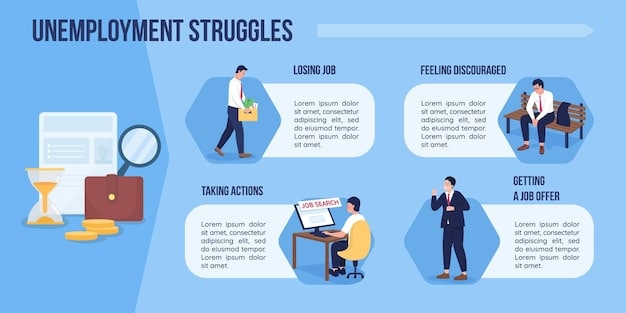Lost Your Job? Your 2025 Guide to US Unemployment Benefits

Lost your job? This step-by-step guide for 2025 simplifies applying for US unemployment benefits, covering eligibility, application processes, required documentation, and strategies for managing your finances during unemployment.
Navigating the unemployment system can feel overwhelming, especially after losing your job. This guide breaks down the process of applying for US unemployment benefits in 2025, providing you with a clear, step-by-step approach to securing the financial support you deserve.
Understanding US Unemployment Benefits in 2025
Unemployment benefits offer temporary financial assistance if you lose your job through no fault of your own. These benefits are managed at the state level, meaning that eligibility requirements and benefit amounts can vary. Understanding the basics is the first step in navigating the system.
This section covers the key aspects of US unemployment benefits in 2025, focusing on what you need to know before you apply.
Eligibility Requirements for Unemployment Benefits
To be eligible for unemployment benefits, you generally need to meet certain criteria, including:
- Being unemployed through no fault of your own (e.g., layoff).
- Meeting minimum work history and wage requirements.
- Being able and available to work.
- Actively seeking employment.
Each state has specific rules about these requirements, so be sure to check your state’s guidelines.
How Unemployment Benefits are Funded
Unemployment benefits are primarily funded by employer contributions. Employers pay a tax on a portion of their employees’ wages, which goes into a state fund used to pay out unemployment benefits. In some states, employees may also contribute.

Understanding how unemployment benefits are funded can give you a better appreciation of the safety net these programs provide.
Unemployment benefits provide a critical lifeline for individuals who lose their jobs, but they can be complex. By understanding your rights and responsibilities, you can navigate the system more effectively and secure the support you need during a challenging time.
Step-by-Step Application Process: Applying for US Unemployment Benefits
After understanding the basics, the next step is to apply for unemployment benefits. The application process typically involves several stages, from initial filing to ongoing certification.
This section details the step-by-step application process, including the documentation you’ll need and how to avoid common pitfalls.
Gathering Required Documentation
Before you start your application, gather the necessary documents, which may include:
- Your Social Security number.
- Your driver’s license or other form of identification.
- Your employment history for the past 18 months, including the names and addresses of your employers, dates of employment, and reasons for separation.
- Your bank account information for direct deposit of benefits.
Having these documents ready will streamline the application process.
Filling Out the Application
Applications are typically submitted online through your state’s unemployment website. You’ll need to provide detailed information about your employment history, reasons for separation, and contact information. Be honest and accurate in your responses to avoid delays or denials.
Check for typos and ensure all information is correct before submitting your application.
Attending Interviews and Hearings
In some cases, you may be required to attend an interview or hearing to determine your eligibility. Be prepared to answer questions about your job loss and your efforts to find new employment. If you disagree with a determination, you generally have the right to appeal.
Being prepared and responsive throughout the application process is key.
The application process for unemployment benefits can be lengthy and complex, but with careful preparation and attention to detail, you can increase your chances of a successful outcome.
Navigating State-Specific Requirements for Unemployment Benefits
Unemployment benefits are administered at the state level, leading to variations in eligibility requirements, benefit amounts, and application processes. It’s essential to understand the specific rules in your state.
This section overviews state-specific nuances and provides tips for navigating the system in your location.
Researching Your State’s Rules
Start by visiting your state’s unemployment website, which typically contains detailed information about eligibility requirements, application procedures, and benefit amounts. Look for FAQs and online resources that can answer common questions.
Each state has its own unique set of rules and regulations.
Understanding Benefit Amounts and Duration
Benefit amounts and duration vary by state and are typically based on your past earnings. Most states have a maximum weekly benefit amount and a maximum duration of benefits, which can range from 12 to 26 weeks.
Check your state’s guidelines to understand how much you can expect to receive and for how long.

Understanding state-specific requirements is crucial for successfully navigating the unemployment system.
Navigating state-specific requirements can be challenging, but with careful research and attention to detail, you can maximize your chances of receiving the benefits you deserve.
Tips for Successfully Managing Your Finances During Unemployment
Losing your job can be financially challenging. Managing your finances wisely during unemployment is essential for maintaining stability and peace of mind.
This section offers practical tips for budgeting, saving, and exploring additional resources to support you through this transition.
Creating a Budget and Tracking Expenses
Start by creating a budget that reflects your reduced income. Identify essential expenses, such as housing, food, and healthcare, and look for opportunities to cut back on non-essential spending. Track your expenses carefully to stay on track.
A well-structured budget can help you prioritize your financial needs.
Exploring Additional Resources and Assistance Programs
In addition to unemployment benefits, explore other resources that may be available, such as food assistance programs (SNAP), housing assistance, and utility assistance. Contact local charities and community organizations for additional support.
- Supplemental Nutrition Assistance Program (SNAP)
- Temporary Assistance for Needy Families (TANF)
- Low Income Home Energy Assistance Program (LIHEAP)
These programs can provide a safety net while you look for new employment.
With careful planning and resourcefulness, you can navigate the financial challenges of unemployment and emerge stronger on the other side.
Common Mistakes to Avoid When Applying for Unemployment Benefits
Applying for unemployment benefits can be complex, and it’s easy to make mistakes that could delay or jeopardize your eligibility. Being aware of these common pitfalls can help you avoid them.
This section highlights mistakes to sidestep during the application process and ensures a smoother journey.
Providing Inaccurate Information
Always provide accurate and honest information on your application. Misrepresenting your employment history or reasons for separation can lead to denials and penalties.
Double-check all information before submitting your application.
Failing to Meet Work Search Requirements
Most states require you to actively search for work while receiving unemployment benefits. Keep detailed records of your job search activities, including dates, employers contacted, and positions applied for. Be prepared to provide this information upon request.
Work search requirements are strictly enforced.
Not Responding to State Inquiries
Respond promptly to any inquiries from the unemployment office. Ignoring requests for information or failing to attend scheduled appointments can lead to delays or denials. Check your email and mail regularly.
Timely communication is crucial.
Staying Positive and Proactive During Your Job Search
Unemployment can be emotionally challenging. Staying positive and proactive during your job search is crucial for maintaining momentum and achieving your goals.
This section offers strategies for building your confidence, expanding your network, and making the most of your time during unemployment.
Networking and Building Connections
Networking is a powerful tool for finding new job opportunities. Attend industry events, join professional organizations, and reach out to contacts in your field. Let people know you’re looking for work and ask for introductions or advice.
Stay connected and active in your professional community.
Utilizing Online Resources and Job Boards
Take advantage of online resources such as LinkedIn, Indeed, and Glassdoor to search for job openings, research companies, and network with professionals. Update your resume and online profiles to showcase your skills and experience.
- LinkedIn: Professional networking and job searching.
- Indeed: Large job board with diverse listings.
- Glassdoor: Company reviews and salary data.
The digital world offers a wealth of resources for job seekers.
Maintaining a positive mindset and taking proactive steps are invaluable during your job search.
| Key Point | Brief Description |
|---|---|
| 📝 Eligibility | Unemployed through no fault, wage history, available for work. |
| 📂 Required Docs | SSN, ID, employment history, bank info. |
| 📅 State Rules | Benefits, amounts, duration vary by state. |
| 💼 Stay Proactive | Network, build connections; job boards, online resources. |
Frequently Asked Questions
▼
To qualify, you generally must be unemployed through no fault of your own, meet minimum work history and wage requirements, and be able and available to work.
▼
Benefit amounts vary by state and are typically based on your past earnings. Most states have a maximum weekly benefit amount and a maximum duration of benefits.
▼
You’ll typically need your Social Security number, driver’s license, employment history for the past 18 months, and bank account information for direct deposit.
▼
If your claim is denied, you generally have the right to appeal the decision. Follow the instructions provided by your state’s unemployment office for filing an appeal.
▼
Actively search for job openings, network with contacts in your field, attend industry events, and utilize online resources such as LinkedIn and Indeed to find new opportunities.
Conclusion
Losing your job is undoubtedly a challenging experience, but understanding the process of applying for US unemployment benefits can provide a crucial financial lifeline. By following the steps outlined in this guide and staying proactive in your job search, you can navigate this transition with greater confidence and resilience.





